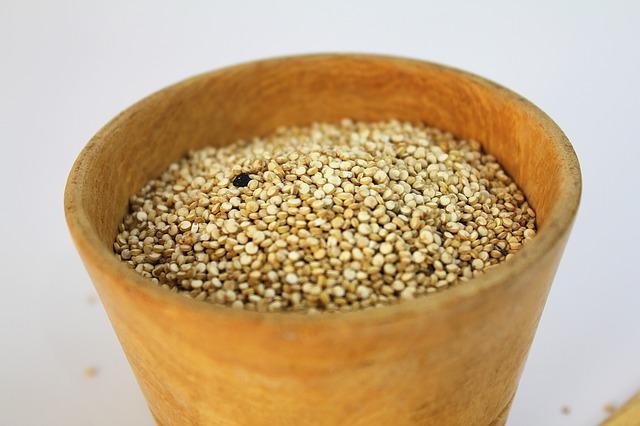
Amaranth, although not a cereal, has many of the beneficial properties of this food category; indeed, in terms of protein content, it far exceeds cereals. Completely gluten-free, it is also suitable for those suffering from celiac disease.
Amaranth is a herbaceous plant belonging to the Amarantaceae family that produces these small black, ivory or red seeds. The plant also obtains the oil and leaves, which can also be eaten raw. It falls into the category of pseudocereals, i.e. foods with nutritional characteristics similar to cereals, which do not contain gluten but from which a flour is obtained with which to make bread and other baked goods.
It is a plant with very ancient origins, as together with corn and quinoa it represented one of the most appreciated foods by the Incas and Aztecs. Today it is grown all over the world, even as an ornamental plant.
Flour is obtained from amaranth , but there is also puffed amaranth, used for breakfast or to produce bars and beer, produced from seeds sprouted and fermented. Oil is also obtained from the seeds. Amaranth is rich in nutritional properties from which its many benefits derive. Let’s find out better.
Amaranth: calories and nutritional values
Amaranth is mostly made up of carbohydrates and a high protein intake. The proteins present are of high biological value, i.e. they contain essential amino acids, which our body is unable to synthesize but must be taken with food.
Despite being a food with a high carbohydrate content, amaranth has a low glycemic index, so it is suitable for those suffering from diabetes or glucose intolerance. Finally, remember that 100 grams of amaranth offer 371 calories.
Nutritional values per 100g of amaranth:
- Waterfall: 11 gr
- kcal: 371
- Proteins: 13.56 gr
- Fat: 7 gr
- Fibers: 6.7 gr
- Carbohydrates: 65 gr
- Soccer: 159 mg
- Magnesium: 248 mg
- Potassium: 508 mg
- Phosphorus: 557 mg
- Iron: 7.61 mg
- C vitamin: 4.2 mg (7% RDA)
- Vitamin B1: 0.116 mg (8.3% RDA)
- Vitamin B2: 0.2 mg (12.5% RDA)
- Vitamin B3: 0.923 mg (5.1% RDA)
- Vitamin B5: 1,457 mg (24.3% RDA)
- Vitamin B6: 0.591 mg (29.6% RDA)
- Folate: 82 µg (41% RDA)
- Vitamin E: 1.19 mg (11.9% RDA)
- Glycemic index: 35
- Cholesterol: 0 g
Amaranth: nutritional properties
Like quinoa, amaranth also has properties that make it similar to a cereal, but in fact it is not, therefore it does not contain gluten and can be included in the diet of those suffering from celiac disease.
Among the minerals, the iron content is high, compared to cereals or other pseudo-cereals. But also phosphorus, magnesium and potassium are present in excellent quantities. It is also rich in dietary fiber and calcium; it also contains vitamins of the B complex and vitamin C.
The leaves of the amaranth plant are richer in iron than the seeds and can be cooked in a similar way to spinach. Let’s now see the characteristics of the main components.
- Iron: amaranth is very rich in iron, so it is recommended to take it in case of anemia or increased need for this mineral and accompany it with foods rich in vitamin C, such as black riber and kiwi, which facilitates its absorption;
- Phosphorus: amaranth contains 557 mg of phosphorus, an excellent amount compared to the recommended daily amount of about 700 mg. We find phosphorus in the mineral fraction of bones and teeth but also in the structure of various enzymes, thanks to which it participates in processes such as cell repair;
- Magnesium: this mineral present in amaranth is essential for the proper functioning of the nervous system, in particular of nerve impulses, and for muscle contraction. A magnesium deficiency can lead to irritability, muscle cramps, insomnia, PMS etc;
- Potassium: potassium is contained in excellent quantities in amaranth. This gives it further benefits as potassium is able to reduce blood pressure and facilitate the elimination of excess fluids, also helping in case of cellulite. It also regulates heart rate and ion balance, modulates the transmission of nerve impulses and muscle contraction;
- Vitamin B5: the pantothenic acid contained in amaranth is a precursor of coenzyme A, essential for the synthesis of macronutrients (carbohydrates, proteins and fats). It regulates the processes of growth and development;
- Vitamin B6: the consumption of amaranth is also important for the nervous system, thanks to its pyridoxine content which is essential for synthesizing the sheath that covers neurons, myelin, and regulates the synthesis of some neurotransmitters. Its deficiency can lead to insomnia, nervousness and depressive states;
- Folate: in the intestine, folate is transformed into folic acid, a vitamin essential for the growth, development and functions of the nervous system. Its deficiency in pregnancy can lead to serious fetal malformations in the unborn child. Folic acid also becomes part of the synthesis process of amino acids and hemoglobin. Amaranth provides about 40% of the folate needed by the body.
Amaranth: health benefits
As we have seen, amaranth is rich in nutrients that give it useful properties for health, in particular for cardiovascular and gastrointestinal health, but not only. Let’s take a closer look at all the benefits of amaranth.
✓ Has a high protein content
Compared to classic cereals such as wheat, amaranth has a high amount of biologically important proteins as they are made up of essential amino acids. Amaranth is therefore useful for those who have chosen a vegetarian but above all vegan diet, because it provides a good amount of vegetable proteins.
✓ It is gluten-free
As already mentioned, amaranth does not contain gluten, that is the protein complex that causes celiac disease in genetically predisposed subjects. Therefore this food can be consumed by celiacs and also by those suffering from gluten intolerance, providing, like cereals which however contain gluten, an adequate supply of complex carbohydrates.
✓ Amaranth for the health of the gastrointestinal system
Thanks to the absence of gluten and the high fiber content, amaranth is particularly digestible and is also recommended for people with gastrointestinal disorders. For the same reason, it is also suitable for the diet of the elderly and can be included in the baby’s diet from the earliest stages of weaning.
✓ Prevents anemia
Amaranth contains a good amount of iron, so its regular consumption can help prevent an anemic state resulting from a lack of this mineral. To optimize the absorption of plant-based iron, it is essential to combine it with foods rich in vitamin C such as oranges, kiwis, red fruits and crucifers.
✓ Amaranth for cardiovascular health
This property of amaranth is due to its content of fibers and phytosterols, i.e. molecules that have the ability to lower the levels of LDL cholesterol, the bad one, and triglycerides. This results in a beneficial effect on heart health. A study has shown how the addition of amaranth flour to wheat flour to make bread is able to improve the lipid and glycemic profile.
Furthermore, in another study, patients with coronary heart disease and hypertension, in whose diet amaranth was introduced, obtained benefits on the values of blood pressure, total cholesterol, LDL cholesterol (the bad one) and triglycerides.
✓ Fights diabetes
Amaranth has a low glycemic index compared to grains, so diabetics can consume it without having annoying insulin spikes. In addition, the fiber content helps to further decrease the absorption of sugars. The richness of protein also helps to regulate blood sugar levels.
How much amaranth to eat?
One serving of amaranth is equivalent to about 80 grams and provides about 300 kcal. Based on this, it is therefore possible to include amaranth in the diet even every day, replacing other cereals. However, remember that a healthy and balanced diet is also based on the variety of foods brought to the table. Therefore, it is certainly advisable to include amaranth in the diet (even 3 or 4 times a week) but it should be alternated with other cereals or pseudocereals such as rice, spelled, quinoa or buckwheat. In this way we will offer our body a greater variety of nutrients.
Amaranth: how to use and consume it
Although it is not widely used in cooking, amaranth lends itself to numerous recipes. It can in fact be used to prepare soups, gnocchi and flans but also cold salads with vegetables, meatballs and vegetable burgers. Amaranth should be cooked in a lot of water and for a long time, usually 30-40 minutes. Before use, however, it is advisable to wash it thoroughly under running water.
Also you can make amaranth popcorn. In fact, amaranth seeds explode when heated, just like corn. The process for making amaranth popcorn is similar to that used for corn.
Amaranth: contraindications and potential negative effects
The consumption of amaranth is naturally contraindicated in subjects who have an individual allergy or intolerance. It is not recommended for use in those suffering from kidney diseases, gout and rheumatoid arthritis as the other oxalic acid content of amaranth inhibits the absorption of calcium and zinc. It is also advisable not to combine amaranth with high protein foods since it already contains a good amount of protein.






